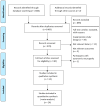Cardiovascular Health Benefits of Exercise Training in Persons Living with Type 1 Diabetes: A Systematic Review and Meta-Analysis
- PMID: 30781593
- PMCID: PMC6406966
- DOI: 10.3390/jcm8020253
Cardiovascular Health Benefits of Exercise Training in Persons Living with Type 1 Diabetes: A Systematic Review and Meta-Analysis
Abstract
Exercise is advocated in the management of type 1 diabetes (T1D), but the effects of different forms of exercise training on cardiovascular risk factors in T1D still remain unclear. The aim of this study was to conduct a systematic review and meta-analysis on exercise training for cardiovascular risk factors in T1D. Six electronic databases were systematically searched for randomized or non-randomized controlled studies reporting associations between exercise training and cardiovascular risk factors in T1D. Weighted mean differences (WMD) of each cardiovascular risk factor between exercise groups and control groups were calculated using a random effects model. A total of 24 studies reported the effects of exercise training on cardiovascular risk factors. Exercise training increased maximal aerobic power (3.01 mL·kg-1·min-1, 95% confidence interval, CI, 0.94 to 6.38) and reduced glycated hemoglobin (HbA1c; -0.45%, 95% CI -0.73 to -0.17), daily insulin dosage (-0.88 U·kg-1, 95% CI -1.27 to -0.48), and total cholesterol (-0.38 mmol·L-1, 95% CI -0.71 to -0.04). Exercise training did not lead to consistent changes in body mass index (BMI), blood pressure, triglycerides, high-density lipoprotein cholesterol (HDL-C), or low-density lipoprotein cholesterol (LDL-C). In persons living with T1D, exercise training is associated with a beneficial cardiovascular profile, including improvements in lipid profile, glycemic control (decreased daily insulin dosage and HbA1c), and aerobic fitness.
Keywords: cardiovascular health; exercise training; type 1 diabetes.
Conflict of interest statement
The authors declare no conflict of interest.
Figures
References
-
- Salem M.A., AboElAsrar M.A., Elbarbary N.S., ElHilaly R.A., Refaat Y.M. Is exercise a therapeutic tool for improvement of cardiovascular risk factors in adolescents with type 1 diabetes mellitus? A randomized controlled trial. Diabetol. Metab. Syndr. 2010;2:47. doi: 10.1186/1758-5996-2-47. - DOI - PMC - PubMed
-
- International Diabetes Federation Diabetes Atlas. [(accessed on 11 October 2018)]; Available online: http://www.diabetesatlas.org/
-
- Wadén J., Forsblom C., Thorn L.M., Saraheimo M., Rosengård-Bärlund M., Heikkilä O., Lakka T.A., Tikkanen H., Groop P.H., FinnDiane Study Group Physical activity and diabetes complications in patients with type 1 diabetes: The Finnish Diabetic Nephropathy (FinnDiane) Study. Diabetes Care. 2008;31:230–232. - PubMed
Publication types
Grants and funding
LinkOut - more resources
Full Text Sources
Miscellaneous


